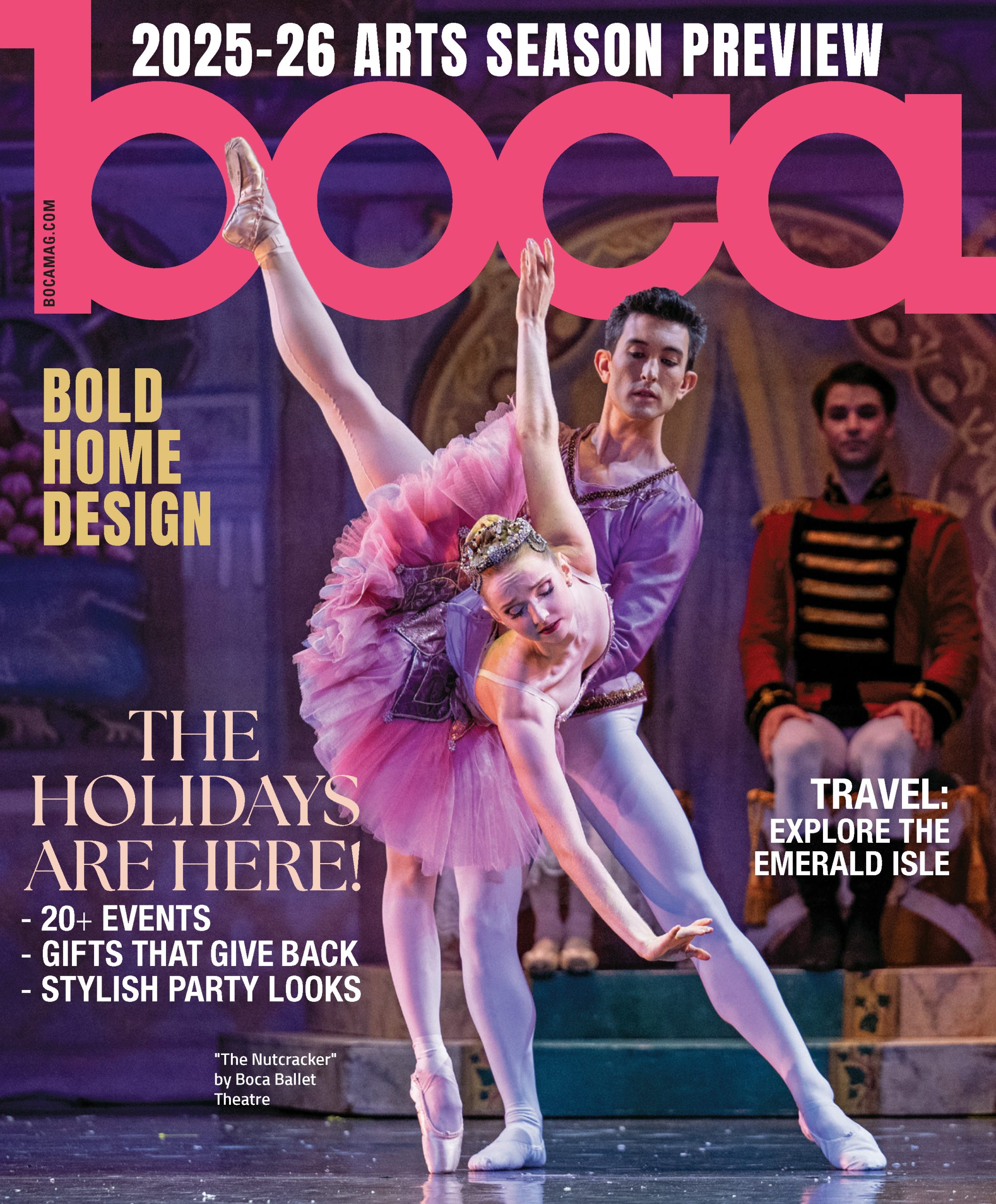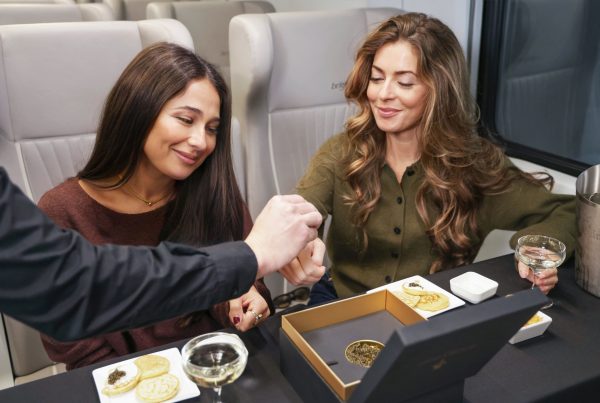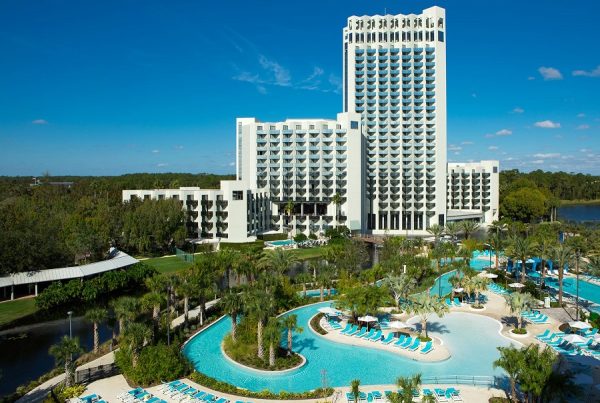This story comes from our April 2017 issue. For more content like this, subscribe to the magazine.
Actually, nowadays in Peru’s historic highland destination, it’s possible to travel in style.
The chef in a crisp white jacket takes slices of fruit from a market vendor and holds them out in her palm. “Whatever you do, don’t eat the seeds,” she warned.
Around her in the Peruvian market is a group of tourists from America. They reach in and grab slices. The skin looks like drab green dragon scales. Inside is a pulpy, stringy fruit the color of spoiled cream. Poisonous black seeds float within, and the flesh smells a bit like French cheese.
“Trust me,” said the chef with a dimply smile. Her name is Thais Rodriguez, the relatively new and wildly talented chef at the JW Marriott in Cusco, a mountainside city in Peru’s historic Sacred Valley. “It’s so good.”
She’s right. As the chirimoya melts on the tourists’ tongues, it tastes a bit like pear and orange. The fruit is nearly as smooth as custard. It’s tree-grown ice cream.
This chef-led exploration of Cusco’s San Pedro Market is one of many novel options for Peruvian tourists these days. Once a destination only for the backpacker and adventure traveler, the Sacred Valley has gone decidedly upscale. Celebrity chefs have opened restaurants here, tasting menus have arrived, and luxury hotels have opened their doors. Tour groups in cushy Mercedes vans now dot the unpaved Andean backroads, and train lunches are more likely to feature tablecloths and bar carts than paper bags. And instead of tourists wandering around the market wondering what they’re seeing, now they can go with Rodriguez, a classically trained chef who happens to make an excellent tour guide.
This revitalization actually returns Cusco to the role it once served centuries ago. In the mid-14th century, emperor Pachacuti built Cusco into the capital of a vast Incan kingdom, fed in part by fertile farmland of what his people called the Sacred Valley. When the Spanish arrived a century later, Cusco became a capital of their conquered South American lands. The settlers built grand cathedrals from the stones of Incan temples and wide European-style squares.

Photo by Eric Barton
But it wasn’t long ago that a trip here was an arduous test of wills. Back in 1986, The New York Times sent writer Nicholas D. Kristof to Cusco. He wrote that the city’s “grandeur is flecked with wizened peasants and malnourished children that recall the African shantytowns surrounding Lagos or Abidjan.” Now, the city’s main square is more akin to southern Spain. Locals and tourists gather on benches that look out on fountains, as diners crowd second-story cafes nestled into arched brick alcoves built by conquistadores.
That said, it’s still implausibly difficult to get to Peru’s most famous tourist attractions, like the salt ponds of Maras and Machu Picchu. The journey begins from South Florida with a six-hour flight to Lima, another hour in a plane to Cusco, and then at least an afternoon there to acclimate to the 11,152-foot altitude, before making it to the place everyone comes for—Machu Picchu.
Acclimation is made easier at places like the JW Marriott. New arrivals are whisked to pillow-covered couches surrounding a wide fireplace, which was part of a 16th-century convent that the Marriott incorporated into its modern structure. A dramatic two-story entrance, stone floors, archways and a sunny interior courtyard all are part of the original religious structure. Next to the fire, newbies to the altitude drink a buzz-inducing tea made of coca leaves and then are urged to avoid altitude sickness with a nap and a light lunch of chicken soup and local trout, and to start their vacation as teetotalers.
The next morning begins early, but Machu Picchu awaits. A bus trip takes you through the shantytown hills of Cusco to the train station, where it’s a three-hour journey to the base of Machu Picchu, a sacred city that clings to a steep mountaintop. Although the only option on this journey used to be a bumpy train with wood bench seats, tourists now can travel far more comfortably. At the top end is the Hiram Bingham, named for the American who rediscovered Machu Picchu in 1911 with help from a local farmer. The Bingham train, at $800 round trip, boasts white linen supper service and a caboose with an open gallery to watch the snow-capped Andes slide by. A better value is PeruRail’s Vistadome, about $200 round trip, with comfortable reclining captain’s chairs and skylight windows to watch the dramatic countryside slowly change from Arizona-like desert highland to lush mountain rainforest.

Photo by Eric Barton
Once the train arrives, there are still limited options, unfortunately, on how to get up to the sacred city. Buses zoom up roads that seem unbelievably cut into the mountain, edges drifting off into blue sky below. At the top, the buses drop tourists off at a parking lot that’s always overflowing with Patagonia-clad Americans and tour guides with varying degrees of knowledge. Pass by the entrance, take a jog to the left, and suddenly you’re at the vista, the one you’ve seen in a million photos on Facebook from friends who have taken this journey. The stunning and somehow spiritual Machu Picchu clings to a plateau, just below a cover of clouds, laid out just as it was six centuries ago, inviting questions about whether it was merely a city or a place to become closer to the gods.
After exploring, it’s back into the daredevil buses, which take tourists back down the mountain to the town of Aguas Calientes. The city gets its name from sulfurous hot springs that bubble out of the sheer cliffs that surround the town, and no doubt things have been blazing here in recent years. As tourism to Machu Picchu has exploded, a town that didn’t exist a generation ago has the feel of a modern gold rush. Just a couple years ago, tour books would have advised skipping the city altogether. But now the luxury Sumaq Machu Picchu hotel has opened across from a river of rapids bouncing over a field of boulders.
Not only does the Sumaq feature suites with whirlpool tubs, but downstairs is a dining room that offers hikers an impressive multicourse tasting menu. It begins with a creative salmon ceviche, topped with a sauce from the creamy chirimoya fruit, dollops of fish eggs, crispy Andean corn and colorful edible flowers. The meal ends with a chocolate egg that bursts open as the server pours a dark chocolate sauce over the top. It’s a meal that would feel at home in Midtown Manhattan, and here it is, served up in Peru’s remote Sacred Valley.

Photo by Eric Barton
Back in Cusco, the dining scene has gone through a revolution in recent years. Chefs, including Peru’s often-lauded Gastón Acurio, have opened outposts, and mini chains feature multiple locations around town serving multicourse meals with modern takes on local dishes. Among them is MAP Café, in a snow globelike glass enclosure inside the courtyard of the historic Museo de Arte Precolombino. The chef, Manuel Cordova, started cooking in Cusco in 1999, back when tourists wanted burgers and pizzas as they backpacked their way through town. Now, Cordova takes the traditional dishes his mother cooked for his seven siblings and adds international ingredients to give them a modern flair. His menu includes a carpaccio made with Andean cheese and local mushrooms, and there’s a cannelloni stuffed with quinoa and truffle. It’s possible to offer such challenging dishes, he said, because his clientele is high-end tourists and locals with more money in their pockets.
“People are demanding something better,” Cordova said. “Now we try to rescue local recipes and elevate them. We want to serve dishes that could be served in any city in the world.”
That’s also true for the city’s boutiques. Once, Cusco was known more for hemp hoodies, cheap t-shirts and alpaca clothing that was quite likely made from inferior wool. Tour books once warned that Cusco salespeople promising fabric made from “baby alpaca” were probably slurring the phrase “maybe alpaca.”

Photo by Eric Barton
Now, stores like the local chain Kuna sell scarves and throws and sweaters woven from alpacas that produce fabric softer than cashmere. Monica Muñoz has worked for Kuna for 18 years and is now manager of the Cusco stores and oversees online sales. “The standards of Cusco have increased in hotels and shops and restaurants and homes,” Muñoz said.
That means the alpaca her stores sell is woven from animals sheared only every two years, and not too much at one time, meaning the animals can still survive the harsh colds of the high altitude. This kind of environmentally friendly approach is common now in Cusco. In fact, many of the tourist buses that jockey in the crowded cobblestone Cusco streets boast of their environmental credentials. It makes sense considering Cusco is a home base for outdoorsy travelers looking to explore the Sacred Valley. Among the destinations for those explorers is the salt mines of Maras, a spot that gets far less attention than Machu Picchu but is perhaps equally as striking.
During a trip to the salt mines, tour guide Francis Casapino explained that the Sacred Valley’s new crop of high-end tourists wants to see environmental responsibility and sustainability, something that’s only going to help locals. “Tourists now care about the environment and the local people,” Casapino said. “They come here wanting to see the area protected, and that is a good thing for Peru.”
Still, Casapino warns that this influx of tourists with more money has had a cost to the local population. Now, Cusco’s tourist hotels and main squares all have Incan descendants who dress in colorful clothing that used to be reserved for festivals. They cradle fluffy alpacas and baby sheep and ask for the equivalent of about 30 cents to pose in a traveler’s selfie. “ Tourists have been very good to Cusco,” Casapino said. “But we also have to be cautious of how the indigenous population is coming into the city just to pose for photos.”

Photo by Eric Barton
At the salt mines, there is no sign of the effects from tourist money. Little has changed at the mines for 6,000 years—nearly a millennia before the Egyptians. The mines are dazzling, a series of hundreds of shallow, car-sized pools cut into a hillside. They catch water flowing out of a salt deposit in the mountain. As the water evaporates in the pools, workers use wooden rakes to collect the crystalized salt that’s left behind. Just like at Machu Picchu, where visitors can freely explore the sacred buildings, visitors to the salt mines have free rein to walk along the precarious edges of the ponds, imagining what it was like for natives to become rich trading salts with other tribes.
Like so much of the Sacred Valley, there’s an otherworldly aspect to the salt mines. Chef Rodriguez, a native of New York City, says that’s what she found almost everywhere when she relocated to Cusco in late 2015 to take over the kitchen at the Marriott.
“As soon as I came here, I noticed that it’s very spiritual, that people do everything for a reason,” she said during the trip to the market. Many of the local foods are credited with curing an ailment, getting a traveler ready for a journey or prepping a worker for a task, and Rodriguez tried to work some of those ideas into her menu. “Having these new types of travelers here, they’re not just backpackers to Machu Picchu. They’re interested in architecture and Incan art and traditional dishes. They’re here for the culture.”
Among the local dishes Rodriguez added to her menu is the pachamanca. The dish has a connection to the religion of the Incas, who divided everything into spheres, or pachas, including the world we live in and the heavens above.
Traditionally the pachamanca is cooked wrapped in leaves inserted under blazing-hot stones and covered in dirt, so it came from the pacha below. Rodriguez cooks hers in the Marriott kitchen, but it still incorporates an herby sauce made from a spice similar to mint, called chincho. It includes large-kernel Andean corn, lima beans still in the pod, goat, beef, chicken and pork belly so soft it nearly melts away on a fork. At the Marriott, it’s served in a traditional large clay chalice that adorns tables in the modern dining room. It’s another sign how a centuries-old tradition has been preserved for the high-end traveler.
And even with the addition of whirlpool baths and linen tablecloth restaurants and trains with cocktail service, the Sacred Valley remains largely the same place that brought backpackers and explorers. It remains an undoubtedly spiritual destination—albeit now with amenities.







